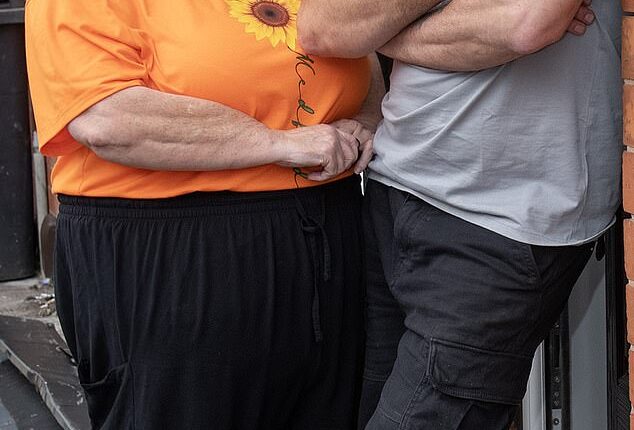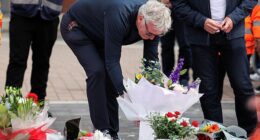There have been a lot of changes since Cathy Gyles and her husband Julian Serra moved into their modest Victorian terraced house more than four decades ago.
Since then, the couple have dedicated their lives to others as NHS workers looking after their community in the Highfields suburb of Leicester and beyond.
They have taken it for granted that those they have cared for and worked alongside have come from a variety of backgrounds.
The 2021 census revealed Leicester had become one of the first cities in the UK where white people are no longer the majority – with 59 per cent of its population coming from minority ethnic backgrounds.
Yet the data reveals a more startling statistic. Cathy, 64, and Julian, 60, are living in a neighbourhood where there are just three white Britons.
Data shows they make up 0.2 per cent of the local population of 1,865 – outnumbered 600 to one by other ethnic groups.
They are now the last white couple living in their street.
Cathy, who works as a mental health professional, told MailOnline: ‘When we moved here, my son was three years old and my daughter was a baby. Now they’re 46 and 43.’

NHS workers Cathy Gyles, 64, and her husband Julian Serra, 60, have seen a lot of changes in their neighbourhood over the 40 years they have lived there
Since then the neighbourhood has continued to change and many from the black community have also moved on. The area is now predominantly home to Asian communities.
Data from the latest census shows that of the 1,865 residents who live in the network of streets, a total of 1,626 are from an Indian background.
That compares with 61 who said they were of Pakistani heritage and 48 who said they were from Bangladesh.
There are 18 people from an African background, 12 are of Caribbean origin and four are Chinese.
Cathy and Julian say they remain comfortable in their surroundings and have no plans to follow in the footsteps of many of their neighbours who have moved out of Highfields.
Speaking of the changing community, Cathy said: ‘I don’t have any problem with that whatsoever. We have a lot of friends here and everyone treats us with respect and kindness.
‘If Julian’s away for a weekend, the neighbours will pop by and check I’m OK and ask if I need anything.
‘They always bring over food. At Christmas they give us gifts and Christmas cards. We return the favour when it’s Eid.
‘My son’s friends are Muslim, Hindu and his best mate is mixed race.
‘He lives in the countryside outside Leicester. So does my daughter. But this is their home.
‘It’s never come into my mind to move – why would it? We all look out for each other here.’
Julian, an NHS clinical trainer, added: ‘We are close with our neighbours but people here don’t live in each other’s pockets.
‘We accept people for who they are and that l think is the mark of a positive multicultural area.
‘I think the world would be a better place if we all looked at each other just as human beings rather than always categorising people into what religion they are. It’s religion which has caused much of the bloodshed in the past.’

Cathy and Julian are two of the only three ‘white Britons’ in the area around their Leicester home, according to the 2021 census. They make up 0.2 per cent of the local population of 1,865 – outnumbered 600 to one by other ethnic groups

Other residents of the Highfields area of Leicester are of primarily Indian heritage, followed by Pakistani, Bangladeshi and then various African and Caribbean countries

Highfields is a bustling neighbourhood with shops that reflect the heritage of many residents

Going nowhere: Cathy and Julian put down roots in this part of Leicester over four decades where they watched their children grow up but most other white neighbours have moved out
Another resident, Elizabeth James, 92, came to Leicester from her native Antigua in 1957.
Her six sons have grown up in Highfields and she and son Shaun go to the local Wesley Hall Methodist Church every Sunday.
She said: ‘There used to be more West Indian families living around here, but now everyone has moved away to different parts of the city and it’s just me and two of my sons.
‘It doesn’t bother me though. I get on well with my Muslim and Hindu neighbours. They check I’m OK and bring me round food. They’re good neighbours.
‘I go to church every Sunday. It’s not as well attended as it used to be, unfortunately. A lot of my neighbours go to the mosque across the road.’
Hr son Shaun, a 55-year-old local authority worker, said: ‘I was born in this house and I’ve grown up in this area with my five brothers.
‘We all went to the school down the road on the corner. We’ve got friends from all different faiths, we all get along well. This is home for me.’
Not everybody is convinced that the neighbourhood is a shining beacon of multi-culturalism.
Some highlight how many families interact only within their own groups while ideological and political feuds point towards Sir Keir Starmer’s concerns that Britain risked becoming ‘an island of strangers’ without tougher immigration policies.
A cricket match between Pakistan in India provided a flashpoint in 2022 when mainly young men from sections of the Muslim and Hindu communities clashed in the streets over a series of nights.
Another notable change in recent times – illuminated by pro-Palestian flags – is the extent to which Gaza has become a mobilising force since the October 7 attacks in Israel.
Adam Seedat, 72, was born in India but settled in Batley, West Yorkshire as a boy.
He came to Leicester as a teenager in 1969 to follow an engineering apprenticeship.
Despite living in Highfields for the last 56 years, he has retained his Yorkshire accent and said: ‘In the late Sixties, Highfields was predominantly working-class white British but there were several West Indian families living here as well as Hindus.
‘But gradually from the 1970s and 1980s onwards the area became more and more Muslim dominated. Things have really shot up in the last 15 years and now most residents have an Islamic background.
‘I miss the days when the area was more mixed. I preferred it in many ways as we used to socialise together and play football in the park.
‘That’s the way things go though. The West Indian families moved north to other parts of the city like Beaumont Leys and the Hindus gravitated more to Belgrave a few miles from here while the British families moved out into the villages and outer suburbs.
‘I think it was safer back then too. There is an issue with crime now, it can be quite bad and the traffic is heavy and parking is a nightmare but there are still a lot of good people here.
‘We show everyone respect and courtesy no matter who they are.
‘I look in on the few Christian and Hindu neighbours and make sure they’re OK. Just because we’re of different faiths, doesn’t mean we can’t look out for each other.
‘Sometimes I challenge Muslims who have just arrived in Leicester from India or Bangladesh because some bring their bad habits with them like throwing rubbish in the street.

Down the road from Haddon Street in Leicester trouble flared in 2022 over a cricket match between Pakistan and India when mainly young Muslim and Hindu men clashed

Officers in Leicester struggled to hold back the crowds of angry mobs in Leicester which led to 25 police officers being injured and 47 people being arrested
‘I’ll say to them “You’re in the UK now, you can’t live like that here”. Mostly they’ll apologise and pick up whatever they’ve thrown on the floor but some will argue back and say things like “Who are you to tell me what to do?”.
‘I think it’s good to be courteous and respectful of the country you’re living in.’
Shop owner Sameer Mamodmia runs S&S Discount Stores. He is a Muslim from the Gujarat region of India who arrived in Britain via Portugal in 2017. He opened his business last May.
Mr Mamodmia said: ‘Most of my customers are Muslim – I’d say about 80 per cent but I get shoppers from all backgrounds in the store because it’s a multicultural area.
‘People here are generally quite welcoming and friendly, I’ve had no problems at all.
‘Back in India most of my friends were Hindus but here in Leicester it’s 50/50 Muslim and Hindu.’








